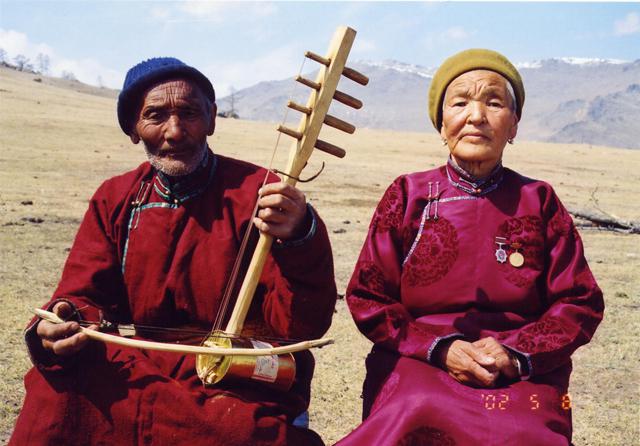
 来源:中国非物质文化遗产网
来源:中国非物质文化遗产网  作者:中国非物质文化遗产保护中心
作者:中国非物质文化遗产保护中心  创建时间:2017-12-28 08:54:00
创建时间:2017-12-28 08:54:00 本文为“一带一路”非遗项目译介专题的第二期
译介项目二
沙士木卡姆音乐
Shashmaqom music

图1 2011年,塔吉克斯坦马卡玛科学院在中国国家大剧院进行的沙士木卡姆演出(来源:人民网)
▲ 项目基本信息
入选年份: 2008
申报国家: 乌兹别克斯坦、塔吉克斯坦
名录名册类型: 人类非物质文化遗产代表作名录(2003年被列入人类口头和非物质遗产代表作,《保护非物质文化遗产公约》生效后,于2008年转入人类非物质文化遗产代表作名录)

图2 塔吉克斯坦沙士木卡姆(来源:联合国教科文组织官方网站)
▲ 英文简介
For over ten centuries, the classical music tradition of Shashmaqom has evolved in the urban centres of Central Asia formerly known as Mâwarâ al-nahr, an area which now encompasses present-day Tajikistan and Uzbekistan. Shashmaqom, meaning “six maqoms”, constitutes a fusion of vocal and instrumental music, melodic and rhythmic idioms and poetry. The genre is performed solo or by a group of singers and an orchestra of lutes, fiddles, frame-drums and flutes. Performances generally open with an instrumental introduction followed by the nasr, the main vocal section consisting of two distinct sets of songs. Dating back to the pre-Islamic era, Shashmaqom was continually influenced by developments in musicology, poetry, mathematics, and Sufism. So popular was the maqom system in the ninth and tenth centuries that numerous music schools were founded, mainly by the Jewish community, in the city of Bukhara, the historical and spiritual centre of Shashmaqom. Shashmaqom genre requires specially trained musicians because the standard notation system can record only the basic framework. Consequently, oral transmission from master to student remains the principal means of preserving the music and its spiritual values. From the 1970s, many of the best-known Shashmaqom performers emigrated from Tajikistan and Uzbekistan to diaspora communities in Israel and the United States. Since Uzbekistan and Tajikistan gained independence in 1991, many measures have been taken to safeguard Shashmaqom. Only a few performers have maintained local performance styles as taught by independent teachers. With the passing of many Shashmaqom masters, the overwhelming majority of presentday performers in Tajikistan and Uzbekistan are graduates of the Tashkent Conservatory, which offers training in Shashmaqom composition.

图3 2011年,塔吉克斯坦马卡玛科学院在中国国家大剧院进行的沙士木卡姆演出(来源:人民网)
▲ 中文简介
十几个世纪以来,沙士木卡姆的古典音乐传统在中亚地区的城市中心演变发展,该地区以前被称为麦尔瓦达安纳德(Mâwarâ al-nahr音译),其范围包括现在的塔吉克斯坦和乌兹别克斯坦两个国家。沙士木卡姆意指“六木卡姆”,它是声乐、器乐、带有旋律韵律的习语和诗歌组成的综合体。此种音乐体裁可独唱或合唱,并由弹弦乐器、拉弦乐器、打击乐器和吹管乐器组成的管弦乐队伴奏。沙士木卡姆的表演通常由器乐为引,而后进入主要声乐部分纳斯尔(nasr音译),即一种由两套截然不同的歌曲组成的声乐表演。沙士木卡姆可追溯至前伊斯兰时期,受到音乐学、诗歌、数学和苏非派神秘主义发展的持续影响。木卡姆体系在九、十世纪盛极一时,在沙士木卡姆的历史和精神中心布哈拉,犹太社区作为主要力量,建立了大量的音乐学校。沙士木卡姆体裁要求乐师经过特殊训练,因为标准记谱法只能记录其基本框架。久而久之,师徒间的口传心授就成为了保存沙士木卡姆音乐及其精神价值的主要方式。从20世纪70年代起,许多久负盛名的沙士木卡姆表演者从塔吉克斯坦和乌兹别克斯坦移居至以色列和美国的移民社区。乌兹别克斯坦和塔吉克斯坦1991年独立后,采取了各种方法保护沙士木卡姆艺术。只有一小部分表演者在独立教师的传授下保留了当地的表演风格。随着诸多沙士木卡姆大师的相继离世,现今塔吉克斯坦和乌兹别克斯坦的绝大多数沙士木卡姆表演者都毕业于塔什干音乐学院,该音乐学院为学生提供沙士木卡姆创作方面的培训。
译介项目三
蒙古族长调民歌
Urtiin Duu, traditional folk long song

图4 蒙古族长调民歌(来源:联合国教科文组织官方网站)
▲ 项目基本信息
入选年份: 2008
申报国家: 蒙古国、中国
名录名册类型: 人类非物质文化遗产代表作名录(2005年被列入人类口头和非物质遗产代表作,《保护非物质文化遗产公约》生效后,于2008年转入人类非物质文化遗产代表作名录)

图5 蒙古族长调民歌(来源:联合国教科文组织官方网站)
▲ 英文简介
The Urtiin duu or “long song” is one of the two major forms of Mongolian songs, the other being the short song” (bogino duu). As a ritual form of expression associated with important celebrations and festivities, Urtiin duu plays a distinct and honoured role in Mongolian society. It is performed at weddings, the inauguration of a new home, the birth of a child, the branding of foals and other social events celebrated by Mongolia’s nomadic communities.The Urtiin duu can also be heard at the naadam, a festivity featuring wrestling, archery and horseracing competitions. The Urtiin duu is a lyrical chant, which is characterized by an abundance of ornamentation, falsetto, an extremely wide vocal range and a free compositional form. The rising melody is slow and steady while the falling melody is often intercepted with a lively rhythm. Performances and compositions of Urtiin duu are closely linked to the pastoral way of life of the Mongolian nomads on their ancestral grasslands. Widely believed to have originated 2,000 years ago, the Urtiin duu has been recorded in literary works since the thirteenth century. A rich variety of regional styles has been preserved until today, and performances as well as contemporary compositions still play a major role in the social and cultural life of nomads living in Mongolia and in the Inner Mongolia Autonomous Republic, located in the northern part of the People’s Republic of China. Since the 1950s, urbanization and industrialization have increasingly superseded traditional nomadic lifestyles, leading to the loss of many traditional practices and expressions. Parts of the grasslands where tradition-bearers used to live as nomads have fallen victim to desertification, causing many families to shift to a sedentary way of life where many classical themes of Urtiin duu, such as the praise of typical nomads’ virtues and experiences, lose their relevance.

图6 蒙古族长调民歌(来源:网络)
▲ 中文简介
蒙古歌曲主要有两种形式,一种是乌日汀道或称“长调”,另一种是“短调”(宝格尼道)。作为重大节庆的仪式表达形式,长调在蒙古族社会享有独特而备受尊崇的地位。在婚礼、新家落成典礼、婴儿降生、烙马印,以及其他蒙古族游牧社区的社会活动中,都能听到长调演唱。在以摔跤、射箭、赛马比赛为特色的节庆活动那达慕大会上,也能听到蒙古族长调。长调是一种抒情歌咏,具有丰富的装饰音、假声、极宽的音域和自由的创作形式。上行旋律缓慢平稳,而下行旋律常常伴有明快的节奏。长调的表演和创作与蒙古族牧民祖辈相传的田园牧歌式生活息息相关。人们普遍认为,长调起源于2000年前,从13世纪起,它就被记录在文学作品中。至今,长调还保留着丰富的地域风格。在蒙古国和中国北部的内蒙古自治区牧民的社会和文化生活中,长调表演和当代创作依然起着至关重要的作用。20世纪50年代以来,城市化和工业化逐渐取代了传统的游牧生活方式,导致许多传统习俗和表达方式的消亡。从前以游牧民身份生活在大草原上的传承人群,由于部分草原的荒漠化,开始了定居生活。这种生活方式的转变,导致长调中的许多经典主题,如对游牧民族特有的美德和生活体验的赞美,失去了现实参照。
往期回顾请点击:【“一带一路”非遗项目译介】第1期:从“一带一路”国家非遗数据说起。更多项目译介,请关注下期内容,我们将持续发布。(翻译:朱颖;翻译校对:李楠;图片:联合国教科文组织官方网站、人民网等)